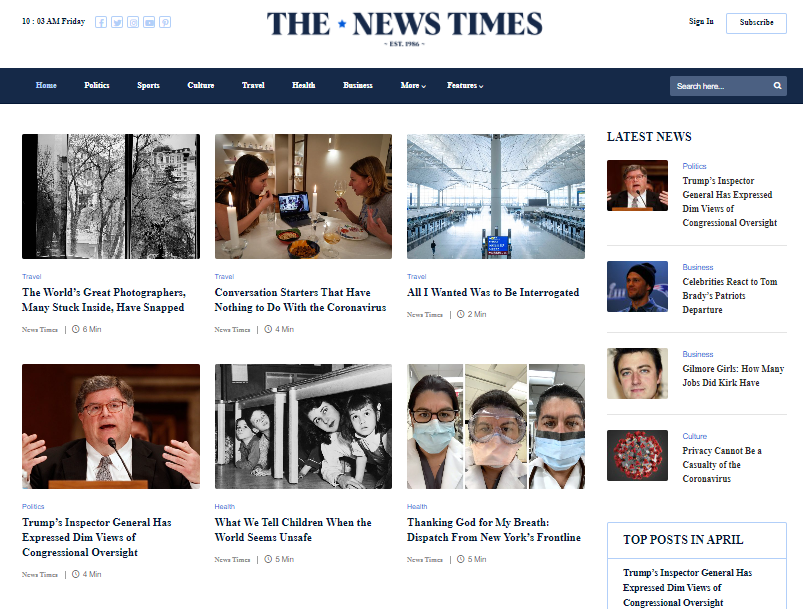Checking out the Future of Journalism: What's Next for News Online?
The future of journalism is evolving rapidly in the electronic landscape. Standard techniques are being tested by brand-new modern technologies and transforming audience habits. Social media, expert system, and interactive narration are reshaping just how details is shared and taken in. As newsrooms adapt, they encounter essential concerns about trust and values. What methods will arise to ensure integrity among these modifications? The answers can redefine journalism as we understand it.
The Impact of Social Media on News Intake
As social networks platforms remain to evolve, they have basically changed news consumption patterns. Traditionally, target markets depend on papers and television for details; nevertheless, the rise of systems like Twitter, Facebook, and Instagram has actually shifted this dynamic - stnews.live. News is currently available in real-time, with customers getting updates straight with their feeds. This immediacy enables fast dissemination of info yet commonly at the expense of thorough fact-checking
Formulas curate web content based on user choices, leading to the sensation of echo chambers, where individuals are exposed largely to viewpoints that line up with their very own. This can prevent crucial interaction with varied viewpoints. Additionally, the interactivity of social networks makes it possible for users to participate in discussions and share content, additionally affecting public discourse. Consequently, the function of standard journalism is advancing, necessitating adaptation to maintain reliability and significance in a progressively electronic landscape.
The Role of Expert System in Journalism
While the assimilation of expert system (AI) into journalism provides interesting opportunities, it likewise increases significant inquiries regarding the future of news manufacturing and intake (stnews.live). AI modern technologies can improve workflows by automating regular tasks such as information analysis, fact-checking, and even material generation. This can improve effectiveness and allow reporters to concentrate on even more complex narration elements. Nevertheless, worries concerning accuracy and prejudice occur as algorithms might unintentionally continue misinformation or mirror the biases of their creators
The usage of AI in personalizing news feeds might lead to echo chambers, where viewers are just exposed to perspectives that strengthen their present beliefs. Moral considerations are extremely important, particularly pertaining to transparency in AI-generated material and the obligation of wire service in utilizing these tools. As AI remains to evolve, its role in journalism will require continuous discussion concerning the implications for integrity, liability, and the overall credibility of news

Technologies in Narration and Multimedia Coverage
The landscape of journalism is being changed by technologies in narration and multimedia reporting. Interactive narration strategies involve target markets in new ways, allowing them to join stories, while online truth journalism engages visitors in experiences that typical layouts can not duplicate. These developments not only boost target market interaction but additionally redefine just how news exists and taken in.
Interactive Storytelling Strategies
Ingenious interactive storytelling strategies are changing the landscape of journalism, engaging target markets in methods standard narratives can not. These strategies integrate multimedia aspects such as videos, infographics, and interactive maps, permitting visitors to explore stories dynamically. By encouraging audiences to browse and individualize their experience, reporters create much deeper connections with their content. Interactive tests and surveys further enhance involvement, encouraging engagement and comments. In addition, social media sites combination makes it possible for real-time discussions, cultivating an area around the tale. Dramatically, these methods not just stand out but likewise promote comprehension of complicated issues, making journalism much more available. As news companies welcome these advancements, the possibility for immersive storytelling proceeds to broaden, shaping the future of how info exists and consumed.
Digital Truth Journalism
As wire service progressively embrace digital reality (VIRTUAL REALITY) innovation, journalism is getting in a brand-new era of immersive narration that captivates audiences like never previously. Virtual reality journalism enables viewers to step into the narrative, experiencing occasions from a first-person viewpoint. This cutting-edge approach improves psychological engagement, as customers can virtually browse dilemma zones, witness historical minutes, or explore complicated social problems. By combining standard coverage with 360-degree video clip and interactive aspects, virtual reality journalism advertises deeper understanding and empathy. Obstacles continue to be, consisting of access, manufacturing prices, and the demand for moral standards. As the innovation progresses, it guarantees to reshape how news is eaten, pressing the limits of narrative and redefining the connection go to website between journalists and their target markets.
The Transforming Landscape of Newsrooms
While standard newsrooms when acted as the backbone of journalism, they currently encounter substantial alteration due to technological improvements and shifting audience choices. The rise of digital media has actually resulted in the decline of print journalism, prompting wire service to adjust their structures and workflows. Lots of have changed to hybrid models, incorporating online systems with standard reporting approaches to reach broader target markets.
This shift has likewise affected staffing, as newsrooms increasingly hire information experts, social media check this sites strategists, and multimedia journalists to diversify web content and improve engagement. Furthermore, the emphasis on rate and content production has actually caused the implementation of ingenious modern technologies, such as synthetic intelligence, to enhance operations.
As a result, the landscape of newsrooms now reflects a more joint atmosphere, motivating cross-functional teams to interact in providing prompt and pertinent news stories. This advancement indicates a critical duration for journalism as it seeks to browse the complexities of a digital-first globe.
Audience Engagement and the New Dynamics of Depend On
Target market engagement has ended up being critical in developing trust fund within the evolving landscape of journalism. By using interactive storytelling methods and applying openness and accountability steps, wire service can promote a more dependable partnership with their audience. These approaches are vital for adjusting to the brand-new characteristics of trust fund that define modern-day media usage.
Building Rely On Journalism
Count on journalism has actually ended up being significantly vulnerable in a period controlled by false information and fast technical improvements. As target markets come across an overwhelming amount of information, critical legitimate resources has actually ended up being a challenge. Journalists and news organizations are currently urged to focus on transparency and reliability to gain back target market confidence. This consists of giving clear sourcing, fact-checking procedures, and freely attending to mistakes. Engaging target markets directly with social networks and neighborhood forums fosters a feeling of involvement and accountability. Additionally, media proficiency efforts are important, equipping the public with tools to critically examine news material. Ultimately, restoring depend on requires a cumulative effort from reporters, companies, and target markets alike, guaranteeing that top quality journalism prevails among the noise of electronic media.
Interactive Storytelling Strategies
The progressing landscape of journalism demands cutting-edge methods to involve audiences and enhance trust fund. Interactive narration techniques have actually emerged as an effective tool for wire service, permitting them to existing information in dynamic and immersive methods. By integrating multimedia elements such as videos, infographics, and interactive maps, reporters can create engaging stories that urge active involvement from viewers. This interaction promotes a much deeper link to article the content, boosting the overall user experience. In addition, interactive narration can help with tailored material delivery, catering to varied audience rate of interests and choices. As reporters accept these techniques, they not just mesmerize target markets yet likewise contribute to a more enlightened public, ultimately enhancing the trust between wire service and their readers in a significantly electronic period.
Transparency and Liability Measures

The Future of Ethical Journalism in the Digital Age
Honesty continues to be a foundation of journalism, particularly as the electronic age transforms the landscape of information circulation. In this developing setting, ethical journalism encounters unprecedented obstacles and opportunities. The expansion of false information and the rapid spread of unproven news require a restored dedication to accuracy, justness, and openness. Journalists need to browse the complexities of social media sites platforms, where the line between reporting and point of view often obscures.

The increase of fabricated intelligence in content development increases moral inquiries regarding authorship and accountability. As audiences progressively require credibility, media organizations are tasked with reinforcing their honest criteria to keep public trust. Collaborative efforts among reporters, innovation firms, and governing bodies will be crucial in crafting guidelines that focus on moral practices. Inevitably, the future of moral journalism depends upon a cumulative feedback to these obstacles, guaranteeing that honesty stays at the center of news reporting in the electronic age.
Regularly Asked Inquiries
Just How Do News Organizations Monetize Online Journalism Successfully?
Wire service properly generate income from on the internet journalism through diverse approaches, including subscription models, targeted advertising and marketing, funded material, and partnerships. These approaches enable them to produce income while keeping journalistic integrity and involving their audience efficiently.
What Abilities Are Crucial for Future Reporters in the Digital Age?
Future journalists should cultivate digital literacy, multimedia narration, data evaluation, and social networks efficiency. Adaptability and essential reasoning are important, enabling them to browse progressing technologies and target market preferences in a significantly complex media landscape.
Just How Will Journalism Adapt to Altering Target Market Demographics?
Journalism will adjust to altering audience demographics by welcoming varied material formats, leveraging information analytics for targeted storytelling, and fostering community involvement via interactive systems. These methods aim to boost significance and accessibility for progressing readerships.
What Duty Do Citizen Reporters Play in the Future of News?
Person journalists are progressively important fit news narratives, providing varied perspectives and prompt protection. Their payments challenge traditional media, promoting a more comprehensive info landscape, while likewise raising worries concerning accuracy and accountability in reporting.

Exactly How Can Small News Outlets Take On Larger Media Companies Online?
Little news electrical outlets can contend with bigger media companies on the internet by concentrating on niche markets, developing solid area connections, leveraging social networks for interaction, and providing special, regional material that resonates with their audience's particular rate of interests.